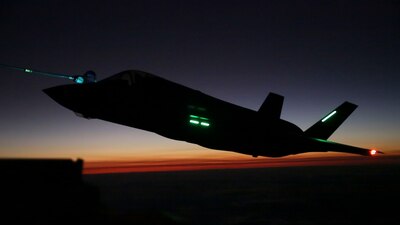By Marine Corps Lance Cpl. Stephen Campbell Marine
Corps Air Station Iwakuni
MARINE CORPS AIR STATION IWAKUNI, Japan, Oct. 27,
2017 — Marines based here conducted a nighttime aerial refueling exercise Oct.
25-26 to improve operational readiness and enhance pilot proficiency.
Marine Aerial Refueler Transport Squadron 152 used
their KC-130J Hercules aircraft to refuel F-35B Lightning II aircraft assigned
to Marine Fighter Attack Squadron 121 and F/A-18C Hornets with Marine Fighter
Attack Squadron 251.
“Every 180 days the squadrons should have completed
at least five successful movement-to-contact scenarios with tankers to stay
proficient,” said Marine Corps Maj. Brian Miller, a KC-130 pilot and aircraft
commander with VMGR-152. “This training exercises our systems, so that we know
our aerial refueling pods, our refueling system and their air refueling systems
are all working.”
The mission of VMGR-152 is to support the Marine
air-ground task force by providing aerial refueling and assault support, day or
night under all weather conditions during expeditionary, joint or combined
operations in the region.
The unit is also capable of aerial deliveries,
assault landing zone operations and battlefield illumination.
Nighttime Challenges
Miller said nighttime aerial refueling can be
difficult due to the reduced vision environment and possible inclement weather.
“We practice this because if we’re conducting a
real-world scenario it’s not always going to be during the day. It could be in
inclement weather at night,” said Miller.
F-35 and F/A-18 pilots perform aerial refueling
exercises to remain tactically proficient during long-range missions. Once
refueling is complete, the pilots can continue executing their mission.
The fighter aircraft carry less fuel than other
types. So, without a KC-130J refueling aircraft providing support, the fighters
could run out of fuel during a mission.
“Anytime we train it keeps the proficiency of the
squadron up,” said Marine Corps 1st Lt. Olivia Raftshol, a KC-130J co-pilot
with VMGR-152. “The training shows that we can meet and refuel aircraft at any
given time and location to keep them in the air longer. It’s pretty
straightforward for us because we do a lot of AR, so it’s just another day in
the life of a KC-130J pilot.”
The units were able to coordinate the mission,
launch on time and execute with a 100 percent success rate.
“If we ever get the call to head north, south, east
or west from here, we know we’ve got tanker and fighter assets that are
trained, capable and proficient to provide them with fuel when they need it,”
Miller said.

No comments:
Post a Comment